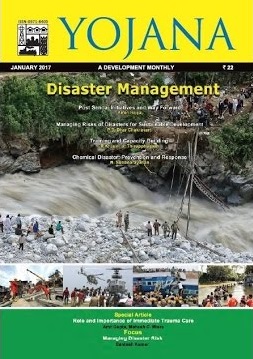(HOT) UPSC Current Affairs 2025 PDF
NEW! The Gist (NOV-2025) | E-BOOKS
(Download) Yojana Magazine Free PDF Archive : January-2017
(Download) Yojana Magazine Free PDF Archive : January-2017
CONTENTS
- Post Sendai Initiatives and Way Forward
- Kiren Rijiju - 7
- Managing Risks of Disasters for
- Sustainable Development
- P G Dhar Chakrabarti-11
Focus
- Managing Disaster Risk
- Santosh Kumar - 15
- Quick Disaster Response: A Specialized Task - 20
- J&K window - 22
- Training and Capacity Building
- R K Jain, V Thirupphugazh - 24
- an Internat ional Perspective
- Kamal Kishore - 29
Special Article
- Role and Importance of
- Immediate Trauma Care
- Amit Gupta, Mahesh C Misra - 34
Do you know? - 39
- Chemical Disasters: Prevention and Response
- M Surianarayanan - 40
- Biological Disasters: Causes and Way Forward
- Archana Sood - 45
- Psychological First Aid:
- A way to de-stress during distress
- Hariharan, Ambreen Khan - 51
- Role and Importance of Effective
- Communication
- C K Nayak - 53
Disasters, whether natural or man-made, have been part of man’s evolution since times immemorial. It is theoretically believed that the creatures that roamed the Earth before the advent of mankind like the dinosaur, the mammoth, the Siberian tiger, to name a few, are supposed to have vanished from the face of the Earth due to some natural disasterclimate change, loss of habitat or even fall of a meteor. The mysterious disappearance of the Indus Valley Civilisation is also attributed by historians to some disaster - the change of course of a river, a drought or an epidemic. Noah’s Ark was built to save species from the floods - a natural disaster.
The Indian subcontinent is among the world’s most disaster-prone areas. As per the current seismic zone map of the country, over 59 per cent of India’s land area is under threat of moderate to severe seismic hazard. Out of the total geographical area of 329 million hectares (mha), more than 40 mha is flood prone. On an average every year, 75 lakh hectares of land is affected, 1600 lives are lost and the damage caused to crops, houses and public utilities is Rs.1805 crores due to floods.
Disasters are, therefore, not strangers to humankind. Droughts, floods, famines, diseases, earthquakes, tsunami - human kind has seen them all. And, yet survived. That is the miracle of human existence - the ability to adapt to circumstances and overcome hardships. This has been well proved during the recent floods in Chennai when people reached out to each other in a tremendous effort of humanity. However, disaster management cannot be left to human effort alone. Some element of preparedness and planning is necessary to handle disasters both on the part of governments and the community because when disaster actually strikes, the time to prepare would have passed. Care shouldn’t start in the emergency room. Organisations like the National Institute of Disaster Management and National Disaster Management Authority are mandated to prepare pre-disaster management plans.
Over the years, losses due to disasters have shown growing trend in terms of lives and property throughout the world due to urbanization, increasing population and increasing degradation of environment. The Bhopal Gas tragedy in 1984, Uttarakhand floods in 2013, Fukushima Daiichi nuclear disaster (2011)which left a trail of eath and devastation, were manmade and could have been avoided.
Natural disasters often strike without warning - like the tsunami which hit the Indian Ocean and left death and destruction behind. They are Nature’s way of showing its power to mankind. And they have to be handled. Hence the need for post disaster response. Disaster teams which can reach a disaster spot immediately well prepared or any emergency is an urgent necessity. That cry for help from below a fallen wall, or buried underneath the earth should be heeded immediately. Medical
teams should be rushed to handle medical emergencies. Post trauma care is the most important requirement at this stage as it may mean the difference between life and death. Locating near and dear ones at the disaster site is another big cause of worry. The National Disaster Response Force was established to fulfill precisely this vital necessity.
Creating awareness among the public is equally important as sometimes a little knowledge can go a long way in mitigating the bad consequences of a disaster. People, especially in disaster prone areas, can be trained to anticipate disaster and to deal with it in case the disaster actually happens. Effective communication is the keyword. The recent floods in Odisha are an ideal example of how a well-thought out communication strategy can assist in disaster management.
But, at the end of the day, disasters do strike. We cannot stop them but we can minimise them and arm ourselves with knowledge, so that too many lives wouldn’t have to be lost. As Benjamin Franklin said “An ounce of prevention is worth a pound of cure”.
Click Here to Download Yojana Magazine January-2017
Courtesy : Yojna Magazine


